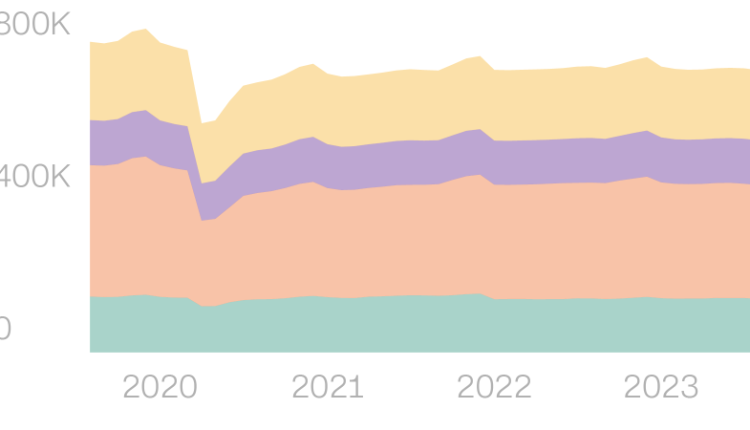Target is closing nine stores in four metropolitan areas: the San Francisco Bay Area, Portland, Seattle, and New York. The big box retailer cited in its announcement organized retail crime and theft creating an “unsustainable business performance.”
But Target is not alone, and it’s not just theft making it hard for retailers: other pressures triggered by the Covid-19 pandemic, like the migration of high earners out of major cities, the rise of e-commerce and a continued worker shortage, have changed business conditions in urban cores, according to CNN’s analysis of economic data.
Even before the pandemic, closures of brick-and-mortar stores were increasing: 2019 saw more retail store closures than 2020 , according to data from Coresight Research. 2022 was the first year without a net loss in the number of stores since 2016.
In a recent survey by the National Retail Federation, retailers reported that shrink — a measure of retail losses that includes external theft as well as other sources of loss — amounted to an average of 1.6% of sales in the 2022 fiscal year. While that is a slight increase from the 1.4% respondents reported in 2021, it’s in line with the estimates from 2020 and 2019.
David Johnston, vice president of asset protection and retail operations for the NRF, said that while “shrink is an indicator, it’s not the indicator.”
Target did not respond to CNN’s requests for comment on this story.
Here are four charts showing what retailers are facing in those areas where Target is closing stores.
As the pandemic unfolded and many office jobs transitioned to remote work, many workers moved away from big cities – large urban counties experienced a net loss of more than 800,000 residents from July 2020 to July 2021. Many of these regions were already experiencing housing affordability crises, said Connor O’Brien, a research analyst with the Economic Innovation Group.
“Some of the highest-cost superstar cities were among the biggest losers in 2020 and 2021,” he said.
Though the rates of this migration away from cities slowed in 2022, the most recently available tax return data from 2021 shows that many of the people who left from 2020 to 2021 were high earners, according to an analysis from the Economic Innovation Group. The six counties where Target is closing stores saw exoduses in high earners larger than the average for similar counties.
O’Brien, who authored the report, said that white-collar office workers, who were likely among the highest earners had some of the most “remotable” jobs. As those workers left the office, they stopped patronizing downtown businesses and their permanent absence reduced demand for retailers in those neighborhoods, O’Brien said.
“The stickiness of remote work perhaps has caused some retailers to reconsider what were previously prime spots,” O’Brien said.
A 2023 McKinsey research report also indicated that changes in preferences around both residential and professional locations contributed to dwindling foot traffic around brick-and-mortar stores in urban cores. Census data also shows that the six counties where Target is closing stores had a higher percentage of remote workers compared to their states as a whole.
Recent estimates from the Department of Commerce suggest that the pandemic-induced boost in online shopping over in-person stores is here to stay.
When Covid-19 hit, online retailers saw their market share grow from around 11% of total retail sales at the end of 2019 to 15% by the end of 2020. Preliminary second-quarter e-commerce sales this year amounted to nearly $280 billion compared to less than $140 billion in 2019.
Though retail sales are still on an upward trajectory, the industry appears to be experiencing a slowdown in growth during recent quarters, following a rebound from the worst of the Covid-19 lockdowns in 2021. US Census Bureau estimates show a preliminary $39 million quarterly increase in retail sales in the second quarter of 2023, a contrast to the $14 billion increase in the previous quarter.
Worker shortages have plagued industries in which employees were considered to be on the “front lines” during the pandemic. While some industries have recovered, a recent US Chamber of Commerce analysis found that in August, 20 percent of vacancies in the wholesale and retail trade sector remain unfilled.
In the markets where Target is closing stores, the shortages persist.
Preliminary August 2023 Bureau of Labor Statistic data shows that all four metropolitan areas where stores are closing – the Bay Area, New York, Portland and Seattle – have fewer retail employees than they did in August 2019.
A McKinsey survey found that 76% of respondents who quit jobs in retail did not return, many citing a lack of job flexibility and low pay. Johnston says retail members of the NRF have told him that crime has exacerbated the industry’s workforce shortage.
“The labor market which was already stressed has become more stressed for certain markets and for certain retailers who are falling victim to these thefts and violence,” he said.
Read the full article here

